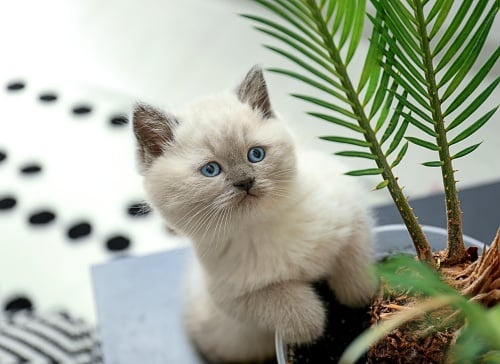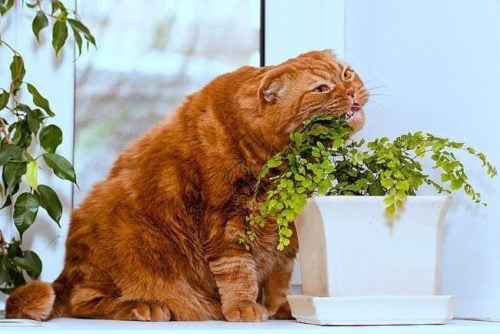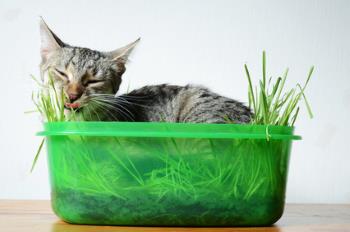This spring, we decided to grow lettuce and dill in our windowsill. What a good intention. We could have fresh salad and herbs to make healthy meals. We planted the seeds with our kids help and we all were excited about the prospects. We were even more excited when the first green plant heads popped out of the black soil. Our joy, however, ended there. Our cats ate them. So how do you get cats to stop eating plants was an article we needed to write. In this article, you’ll learn why your cat eats your plants and 4 ways to get your cat to stop chewing your indoor plants.

Table of Contents
Keeping indoor plants with a cat (or in our case, cats) in the same house is not always easy. Some cats eat the plants down to the soil, whereas others nibble on the leaves excessively making a mess of your intended beautiful indoor garden.
Why cats eat plants
But why do cats eat plants? Unfortunately, scientists are unable to provide an exact answer, and cats are even less likely to explain themselves to us. But here is what we know.

Cats usually vomit after eating grass. This would suggest that they might be deliberately purging their system. Plants also provide fiber, which aids digestion and the passing of hair balls, and they might provide certain vitamins and minerals. Some people say that a cat eating grass is a sign of forthcoming rain, though this isn’t backed by science. The most plausible answer is that cats simply enjoy the activity. Why else would they be doing it?
4 Ways to Stop a Cat From Chewing Indoor Plants
Whatever the reasons, the fact is that cats do eat plants. Forbidding your cat from eating plants sounds simple, but it isn’t easy to do. Instead, repel your cat from indoor plants and provide alternatives.
WARNING: Many indoor plants are toxic to cats. Check this list from the ASPCA. If you have any plants that are toxic to your cats, put them out of your cat’s reach or substitute them with houseplants that are just as beautiful but safe.
1. Make your plants unattractive to your cat
Use a cat-repellent spray on your house plant leaves. You can find such sprays at your local pet store and online. By spraying a bitter-tasting cat repellent on both sides of the plant’s leaves, your cat will find them unappetizing. These sprays work very well because cats are very sensitive to smells and definitely won’t like the taste either. The only downside is that you must reapply them every few days.
Alternatively, if the targeted plants are in only one or a few spots, you can use other forms of cat deterrents, such as motion-activated ones. You can learn more about different cat deterrents here. Many of our patients (us too !) have found success with the PetSafe SssCat spray (this link will take you to our unboxing and demonstration video on the PetSafe SssCat pet deterrent) and electronic mats.
Please don’t punish your cat for eating plants. As you see your cat reaching their shiny teeth toward your plant’s leaves, don’t yell or throw things at them. Let them see and taste the repellent and make their own informed decision. If this doesn’t work, or if you haven’t used a repellent spray on that plant try this technique. Go to your plant and stand exactly where your cat is. They will likely scoot away without feeling scolded. This isn’t a long term solution as your cat only learned to move away from the plant if you are there.
2. Give your cat a plant to eat
Instead of eating plants you like, give your cat a plant they like to eat and one you actually want them to eat. Give your cat kitty grass or cat grass.

If your cat is a plant nibbler, it’s very likely that they enjoy the activity. So instead of taking all plants away, redirect your cats natural tendencies. Pet stores sell small pots with grow-it-yourself kitty grass (or you can get just the seeds), which you can place in two to three locations throughout your house. Cats prefer kitty grass over traditional plants. For the best results, place the kitty grass near your cat’s favorite spots, such as on a windowsill, near their cat tree, or right next to your indoor plants.
3. Increase your cat’s activity level
By increasing your cat’s activity level, they’ll be less likely to look for things to do like eating your houseplants. Cats and dogs usually misbehave because they’re unable to express themselves naturally. Let’s look at it from your cat’s point of view. Your indoor cat doesn’t have to hunt to feed themselves like their ancestors. Your cat isn’t able to leap or run sufficiently to exhaust themselves like they would if they had to hunt for every morsel of food. Your cat also doesn’t have to evade predators and be forced to climb a tree to escape.
So what does your cat do to expend all that energy that they have? Well, they entertain themselves by eating plants like your new Peace Lily plant (please don’t let your cat eat it as it’s mildly toxic to them). There are some plants that are okay for your cat to nibble on. Please understand that your cat is a carnivore. They lack the digestive enzymes to eat plant material. In nature, chewing plants is of very little importance to cats.
However, if your house provides nothing stimulating to do, chewing becomes a primary activity for your cat. Increasing your cat’s activity level will dramatically decrease their urge to eat your plants.
Some ideas are to use treat balls. These are toys that have places for you to put kibble in them. When your cat plays with the treat ball, the kibble falls out and your cat gets rewarded for their efforts. It mimics their natural instinct to hunt for their food and we’ve found most cats enjoy them.
Another idea is to provide climbing opportunities and scratching posts. Lots of activities for your cat ideas can be found in our post: How to reduce your cat’s boredom.
4. Put your plants out of reach
You can also decorate your house so your houseplants are beautifully on display to visitors but out of your cat’s reach. You can put smaller plants out of their reach like on shelves, high furniture, or hung from the ceiling. You could also try plant stands. Remember, your cat is an expert climber so keep that in mind when you try this approach.
How To Get Cats To Stop Eating Plants Summary
You now have 4 ways to keep your cats from eating your plants. Using any one or more of the ways here on how to get cats to stop eating plants should work. As a loving cat owner your first step should be to ensure that none of your plants are toxic to your cats. That way, even if your cat does eat them, why worry? Of course your plants won’t look their best but your cat won’t get sick if they do indulge every now and then. If your cat has enough activities to keep them entertained, then your cat and your plants (even if they chew on them a little) will be fine.
Are you wondering if you have a cat behavior issue? See our list of most common ones here. Following any of these suggestions will make your plants and you happy. And your cat will be happy too. And a happy pet is what we all want.
